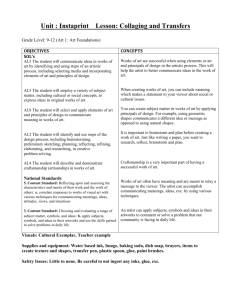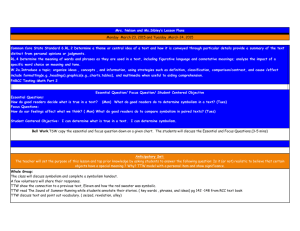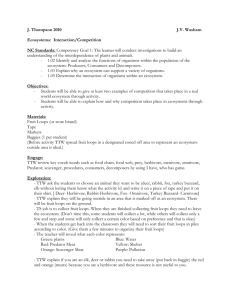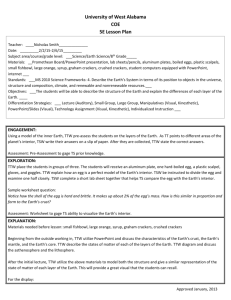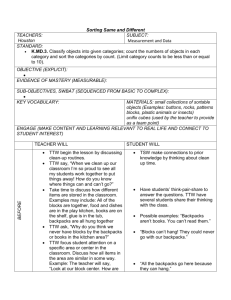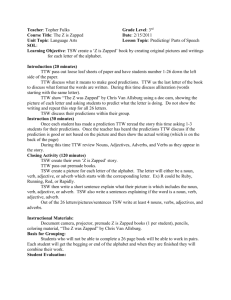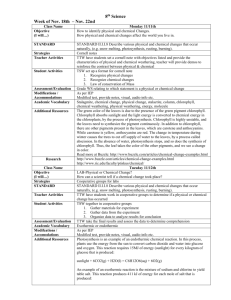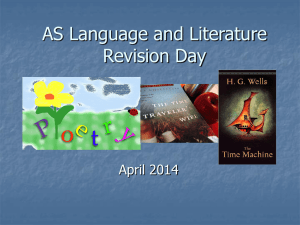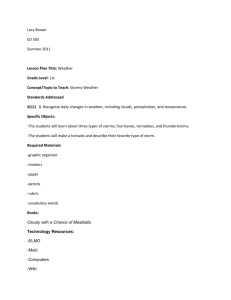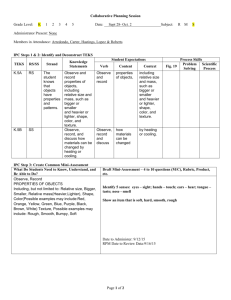ScarbroughK_DILP_LP2_Revised
advertisement
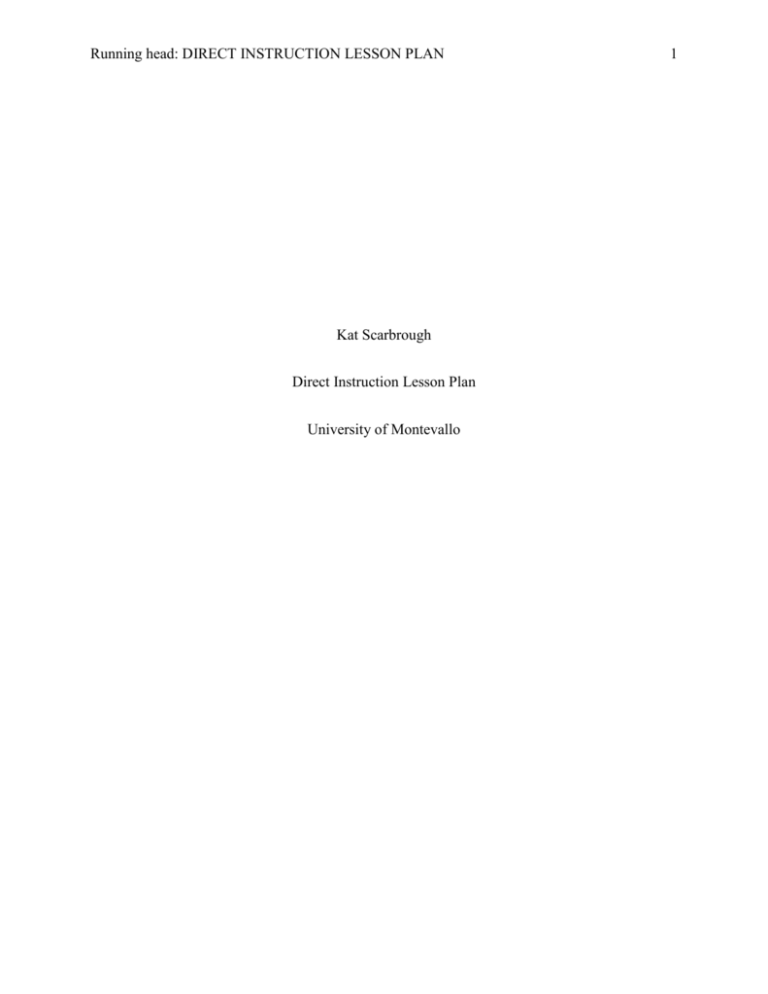
Running head: DIRECT INSTRUCTION LESSON PLAN Kat Scarbrough Direct Instruction Lesson Plan University of Montevallo 1 DIRECT INSTRUCTION LESSON PLAN Direct Instruction Lesson Plan COS Standards: AL.ALEX. 2006. VA. 6-8.1 Create works of art utilizing a variety of traditional and nontraditional media and techniques. AL.ALEX. 2006. VA. 6-8.7 Describe historical and cultural influences on works of art. Details Concurrent Skills/Competency Focus: Knowledge of the elements of art and principles of design Instructional Objectives & Assessments: TSW apply knowledge of the elements of art and principles of design. TSW produce an original two-dimensional work of art that illustrates knowledge of radial balance and unity. Formative assessment will be conducted throughout the project through questioning and discussion. Summative assessment will be conducted after the project is completed. The project will be graded by how well the students implemented the principles of radial balance, unity, and pattern. Neatness and craftsmanship will also be considered. INSTRUCTIONAL PROCEDURES: 2 DIRECT INSTRUCTION LESSON PLAN 3 Phase I. Daily Review TTW briefly review the elements of art and principles of design the students have previously practiced. TTW ask students to identify and discuss these. TTW narrow the focus to the principle of balance and review symmetrical and asymmetrical balance. TTW also specifically review unity and pattern. TTW question students to ensure they understand the concepts. Phase II. Structuring and Presenting Information SET: TTW present students with pictures (see attached) of objects that exhibit radial symmetry and question students about the symmetry and how many lines of symmetry. Next, TTW present students with a PowerPoint (see attached) that reviews types of balance and introduces Mandalas. TTW state and explain lesson objectives. TTW check for student understanding of objectives. TTW inform students that they will first be guided through drawing it with pencil, and then they will design their own unique pattern. After students have drawn their pattern, they will color it in with watercolors. Phase III. Guided Practice TTW model for students how they are to draw a circle in pencil using a compass on a sheet of provided paper. TTW allow students time to draw the circle and check that they are all the correct size. Next, TTW model how to use a straight edge to create four lines of symmetry, dividing the circle into eight even sections. TTW circulate to ensure that all students have done so correctly. Phase IV. Feedback and Correctives DIRECT INSTRUCTION LESSON PLAN 4 When all students have drawn the divided circles correctly, TTW instruct them to begin drawing their designs within the circle. TTW remind students to use repetition of design elements and to work inward out. TTW allow students to do small practice sketches of their design if they feel the need to. TTW closely monitor students’ designs to ensure they understand the concept and are executing it correctly. TTW circulate and give individual feedback to students on the development of their designs. Phase V. Independent Practice TTW allow students time to finish drawing designs in pencil. When the pencil designs are complete, the students can start coloring in with either watercolor paint or watercolor pencils. TTW continue to circulate and give individual feedback as needed. After the design is colored in completely, the student can outline using a sharpie if they desire. When the teacher has approved that the design has been colored and outlined sufficiently, the student can cut out the mandala and glue it to a piece of black construction paper. Closure: TTW review radial symmetry, unity, and pattern. TTW also review what is expected of the finished projects. Weekly and Monthly Reviews The same concepts will be reviewed and built upon in future projects. Materials and Resources Pictures of radial symmetry https://encryptedtbn3.gstatic.com/images?q=tbn:ANd9GcRdG37nekU8leQfUdVFDEo5VbvF1y1K5wVheQyo2P RsrN7dqzTi, https://encrypted- DIRECT INSTRUCTION LESSON PLAN 5 tbn1.gstatic.com/images?q=tbn:ANd9GcT80jE8ViDGrFga9R220TYuWa5e_RSRSuBN5vIAXR pAQF5m-9RCVw PowerPoint (self-generated) Mandala Presentation.pptx Paper Pencil Watercolor paints Watercolor pencils Paintbrushes Sharpies Compasses Stencils Scissors Glue Construction Paper Accommodations Teacher will accommodate special needs students based on their IEPs. Technology Integration DIRECT INSTRUCTION LESSON PLAN 6 PowerPoint software Computer Projector Name: Kat Scarbrough Direct Instruction Lesson Plan Falls Below Expectations (1 pt.) Term: Spring 2013 Meets Some Expectations (3 pts) Meets Expectations (4 pts) Score Course of Study and Concurrent Skills (1x) Lesson Plan does not address COS. Competency focus/Concurrent skills are not listed and/or these are not relevant. Lesson Plan may address COS, but does so incompletely OR standards for technology use are not present if lesson plan includes technology. One relevant concurrent skill focus is listed. Lesson Plan correctly addresses all COS, including technology standards, if necessary. Two relevant competency focus/concurrent skills are listed. 4 Objectives and Assessment (2½ x ) Lesson Plan does not indicate appropriate objective(s) and matching assessment(s). Appropriate assessments are not present within lesson. Lesson Plan indicates the appropriate objective(s) but does not match appropriate assessment(s) and/or the objectives are not numbered. All assessments are identified within the lesson but may not be appropriately labeled. Lesson Plan indicates and numbers appropriate objective(s) which match the assessment(s). All assessments are identified and labeled correctly throughout the lesson. 8 Model Identification and Model Development (1 ½ x) The model is not identified and/or the model does not fit the content of the lesson. LP does not correctly number or label the procedural steps of intended model. The correct model for the lesson plan is identified, but it may not fit content of the lesson or there are problems with protocol. LP correctly numbers and labels some of procedural steps of the intended model. The correct model for the lesson plan is identified and fits the content of the lesson. Lesson Plan correctly numbers and labels all of the procedural steps of the assigned/indicated model. 2 Set and Closure (2x) Lesson Plan does not have appropriate set and closure. Lesson Plan has either an appropriate set or closure, or the set and closure are not identified properly. Lesson Plan has an appropriate set and closure and both are identified within the lesson correctly. 6 Materials and Resources (1½ x) Lesson Plan does not indicate appropriate materials and resources Lesson Plan indicates some, but not all, necessary materials and resources or the materials; however, resources are not labeled correctly within the lesson plan. Lesson Plan indicates all appropriate materials and resources, and the resources are labeled correctly within the lesson plan. 3 Accommodations Lesson Plan lacks appropriate Lesson Plan attempts to provide (1x) accommodations for EL, special accommodations for EL, special education, and diverse populations. Technology Integration (1x) Lesson Plan does not demonstrate appropriate use of technology, including tools & rationale for technology used, OR No technology use is present within the lesson but the lesson would definitely benefit Lesson Plan provides appropriate 4 accommodations for EL, special education, and diverse populations, education, & diverse populations, but these items are inadequate or and it includes the IEP statement incomplete, or IEP statement is within the accommodations missing from the accommodations section. section. Lesson Plan demonstrates appropriate use of technology but insufficient information about the tools or rationale is present OR No technology use is present within the lesson but the lesson might be enhanced from its use. Lesson Plan demonstrates the appropriate use of technology with sufficient information about tools used and rationale OR No technology is needed within the lesson 4 DIRECT INSTRUCTION LESSON PLAN 7 from use. GrammarSpelling Punctuation (2x) Lesson Plan has multiple grammatical, spelling, or punctuation errors. Lesson Plan has a few minor grammatical, spelling, or punctuation errors. Lesson plan has no grammatical, spelling, or punctuation errors. 7 38/50 Comments: So far, your lesson plan follows the Direct Instruction protocol fairly well except for leaving out two steps. Look at my notes throughout, especially in creating a more effective “Set Induction.” Move your assessment statements to the Objectives section of your lesson plan. I also need for you to submit the PowerPoint presentation. You can revise and resubmit for the possibility of increased points. Good work so far!
